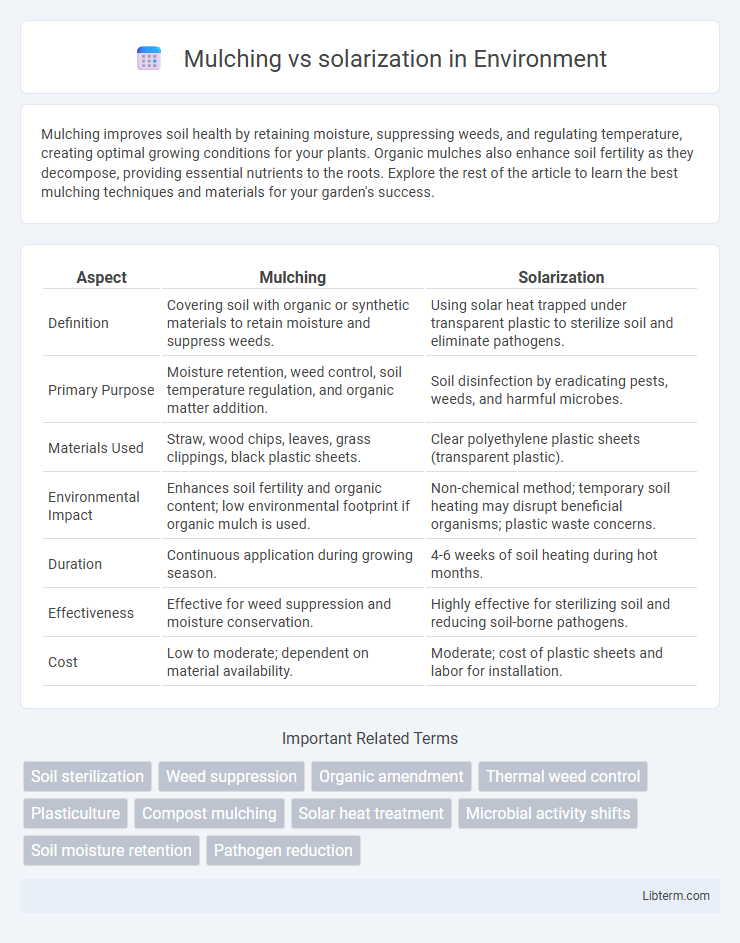Mulching improves soil health by retaining moisture, suppressing weeds, and regulating temperature, creating optimal growing conditions for your plants. Organic mulches also enhance soil fertility as they decompose, providing essential nutrients to the roots. Explore the rest of the article to learn the best mulching techniques and materials for your garden's success.
Table of Comparison
| Aspect | Mulching | Solarization |
|---|---|---|
| Definition | Covering soil with organic or synthetic materials to retain moisture and suppress weeds. | Using solar heat trapped under transparent plastic to sterilize soil and eliminate pathogens. |
| Primary Purpose | Moisture retention, weed control, soil temperature regulation, and organic matter addition. | Soil disinfection by eradicating pests, weeds, and harmful microbes. |
| Materials Used | Straw, wood chips, leaves, grass clippings, black plastic sheets. | Clear polyethylene plastic sheets (transparent plastic). |
| Environmental Impact | Enhances soil fertility and organic content; low environmental footprint if organic mulch is used. | Non-chemical method; temporary soil heating may disrupt beneficial organisms; plastic waste concerns. |
| Duration | Continuous application during growing season. | 4-6 weeks of soil heating during hot months. |
| Effectiveness | Effective for weed suppression and moisture conservation. | Highly effective for sterilizing soil and reducing soil-borne pathogens. |
| Cost | Low to moderate; dependent on material availability. | Moderate; cost of plastic sheets and labor for installation. |
Introduction to Mulching and Solarization
Mulching involves covering soil with organic or inorganic materials to retain moisture, regulate temperature, and suppress weeds, improving overall soil health. Solarization uses clear plastic sheets to trap solar energy, raising soil temperature to levels that eliminate soil-borne pests, pathogens, and weed seeds. Both techniques enhance soil quality but differ in mechanism and purpose: mulching conserves moisture and nutrients while solarization targets soil sterilization through heat.
Defining Mulching: Methods and Materials
Mulching involves covering the soil surface with organic or inorganic materials such as straw, wood chips, plastic film, or compost to retain moisture, suppress weeds, and regulate soil temperature. Common mulching methods include spread mulching, where materials are laid directly on the soil, and sheet mulching, which integrates layers of organic matter to improve soil fertility. Organic mulches decompose over time, enriching the soil, while inorganic mulches primarily provide physical protection without nutrient contribution.
Understanding Soil Solarization: Process and Techniques
Soil solarization is a non-chemical method for controlling soilborne pests by harnessing solar energy to heat the soil to temperatures lethal to pathogens, weeds, and nematodes. This process involves covering moist soil with transparent polyethylene plastic for 4 to 6 weeks during peak summer, allowing the sun's rays to trap heat and raise soil temperatures to 45-60degC. Effective soil solarization requires proper site selection, soil moisture adjustment, and the use of durable plastic films to maximize thermal conductivity and pest control efficacy.
Key Benefits of Mulching
Mulching enhances soil moisture retention by reducing evaporation, leading to improved water efficiency in agricultural practices. It suppresses weed growth, minimizing competition for nutrients and reducing the need for chemical herbicides. Furthermore, mulching enriches soil fertility through organic matter decomposition, promoting healthier plant growth and increased crop yields.
Major Advantages of Solarization
Solarization offers major advantages by effectively controlling soilborne pathogens, weed seeds, and nematodes through prolonged exposure to high soil temperatures, which mulching alone cannot achieve. It enhances nutrient availability and increases microbial activity, leading to improved soil health and crop yields. Solarization is an eco-friendly, chemical-free method that reduces reliance on pesticides and herbicides, promoting sustainable agricultural practices.
Limitations and Drawbacks of Mulching
Mulching can hinder soil aeration and water penetration, leading to potential root suffocation and increased risk of fungal diseases. Organic mulches may decompose unevenly, attracting pests or harboring weed seeds that reduce its weed suppression effectiveness. Compared to solarization, mulching typically provides less soil temperature elevation, limiting its efficacy in controlling soil-borne pathogens.
Challenges and Disadvantages of Solarization
Solarization faces challenges such as requiring prolonged exposure to high temperatures, which may not be feasible in cooler climates or during shorter growing seasons. Soil solarization can also lead to the temporary loss of beneficial soil microorganisms and may require clear plastic materials that degrade over time, contributing to environmental waste. Furthermore, its effectiveness diminishes in shaded areas or in soils with high moisture levels, limiting its applicability for diverse agricultural settings.
Comparing Effectiveness: Mulching vs Solarization
Mulching improves soil moisture retention, temperature regulation, and weed suppression while also enhancing organic matter over time, making it effective for long-term soil health. Solarization uses clear plastic sheets to trap solar energy, raising soil temperatures to levels that kill pathogens, weed seeds, and pests, providing rapid sterilization within weeks. Solarization offers superior pathogen control, whereas mulching excels in organic matter enrichment and soil conditioning, with the choice dependent on specific pest management or soil health goals.
Environmental Impact and Sustainability Considerations
Mulching enhances soil moisture retention, reduces erosion, and promotes biodiversity by supporting beneficial microorganisms, resulting in improved soil health and reduced need for chemical inputs. Solarization uses solar heat to control soil-borne pests and weeds, decreasing reliance on pesticides but requires energy input and plastic use, raising concerns about waste and carbon footprint. Both methods offer sustainable benefits, with mulching generally favored for long-term soil ecosystem balance, while solarization provides rapid pest control with environmental trade-offs.
Choosing the Best Method: Factors to Consider
Mulching conserves soil moisture and suppresses weeds, making it ideal for areas with limited water supply, while solarization uses heat from the sun to reduce soil-borne pathogens and pests, best suited for warm, sunny climates. Soil type, crop sensitivity, and desired outcomes like weed control or disease reduction are critical factors in selecting between these methods. Cost, environmental impact, and duration of treatment further influence the decision, with mulching providing immediate benefits and solarization requiring several weeks for effective results.
Mulching Infographic

 libterm.com
libterm.com